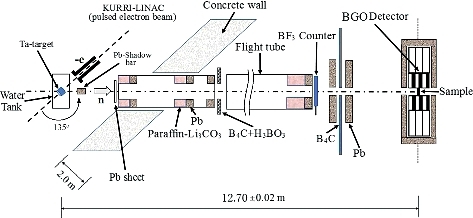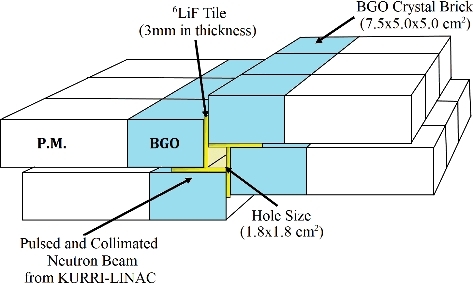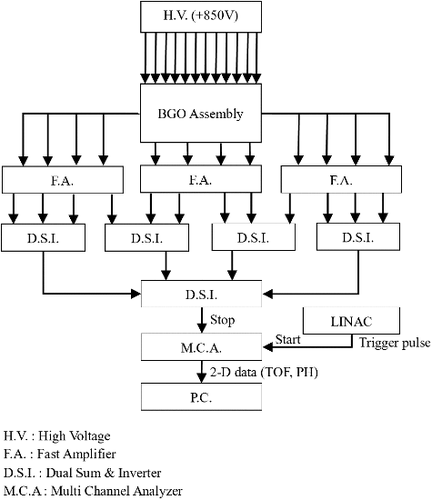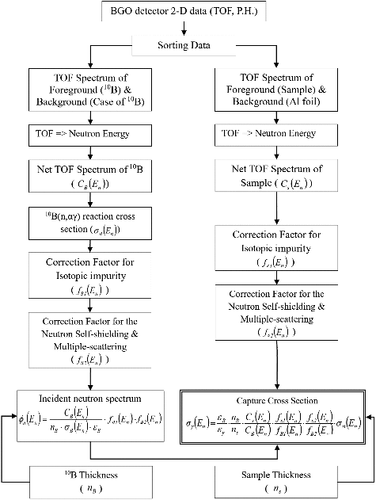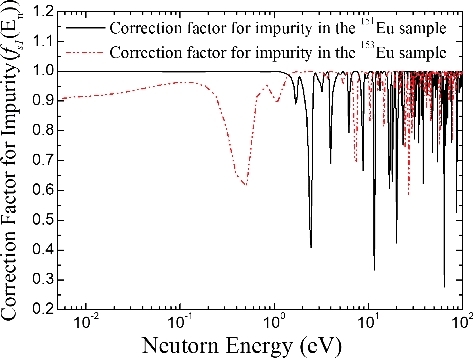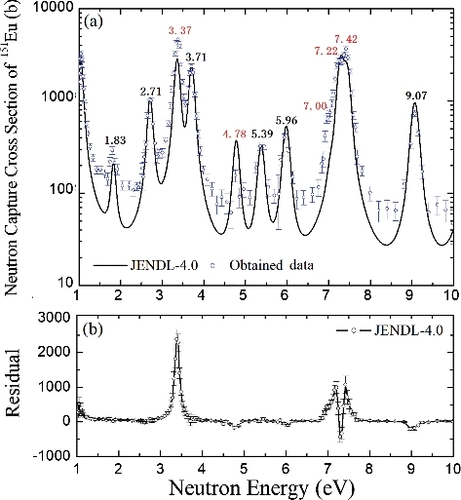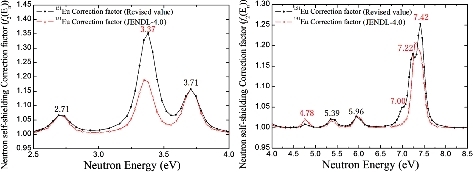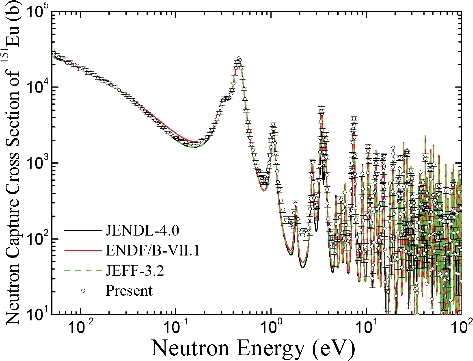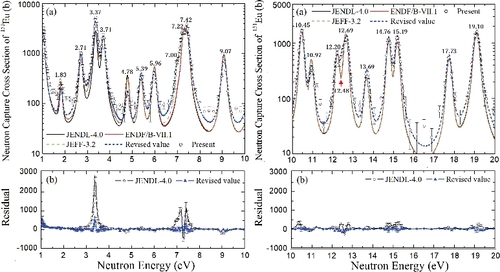 ?Mathematical formulae have been encoded as MathML and are displayed in this HTML version using MathJax in order to improve their display. Uncheck the box to turn MathJax off. This feature requires Javascript. Click on a formula to zoom.
?Mathematical formulae have been encoded as MathML and are displayed in this HTML version using MathJax in order to improve their display. Uncheck the box to turn MathJax off. This feature requires Javascript. Click on a formula to zoom.ABSTRACT
The neutron capture cross sections of Europium-151 and Europium-153 have been measured by the time-of-flight method in the energy range from 0.005 to 100 eV using the Kyoto University Research Reactor Institute-Linear Accelerator (KURRI-LINAC). An assembly of Bismuth Germanate (BGO) scintillators was used to detect the prompt capture of γ rays. The absolute values of the neutron capture cross sections of 151Eu and 153Eu were deduced by normalizing the thermal capture cross sections in JENDL-4.0 and ENDF/B-VII.1, respectively. Then, we have obtained the resonance parameters of 20 resonances in 151Eu and 17 resonances in 153Eu using the code SAMMY.
For the 3.36-eV resonance of 151Eu, the evaluated resonance peak area in JENDL-4.0 is about 95% smaller than the present result. For the 7.00-, 7.22-, and 7.42-eV resonance; we confirmed that there are significant differences between the measured peaks and evaluated peaks in JENDL-4.0, ENDF/B-VII.1, and JEFF-3.2. For the 153Eu, the evaluated resonance peak areas in JENDL-4.0, ENDF/B-VII.1, and JEFF-3.2 are about 15% larger than the measured resonance peak areas at the 2.46-, 3.29-, and 3.94-eV resonances.
1. Introduction
Europium-153 is one of the most important fission products in burn-up credit consideration [Citation1] for criticality safety in the transportation, storage, and treatment of spent nuclear fuel. Since the double neutron capture reaction of 153Eu produces a strong absorber, 155Gd [Citation2], via β decay, the 153Eu(n,γ) reaction has an important role in a chain of absorbing isotopes.
Europium has two stable isotopes, 151Eu and 153Eu. Since the effect of isotope impurity in the 153Eu enriched-sample on the capture yield is considerable, the accurate neutron capture cross sections of 151Eu are also necessary.
For this reason, there were prominent experiments [Citation3–8] to obtain the capture cross sections of 151Eu and 153Eu.
We measured the absolute neutron capture cross sections of 151Eu and 153Eu at the Kyoto University Research Reactor Institute-Linear Accelerator (KURRI-LINAC) using a pair of C6D6 detectors in the energy range from 0.005 eV to keV region by employing the pulse-weighting technique as a previous work [Citation9]. Then, we found that our data on the thermal neutron capture cross section at 0.025 eV of 153Eu supported the evaluated data of ENDF/B-VII.1 [Citation10] (358 b) rather than those of JENDL-4.0 [Citation11] and JEFF-3.2 [Citation12] (312.7 b). For the thermal energy region from 0.03 to 0.2 eV of 151Eu, our data supported the evaluated data of JENDL-4.0 and JEFF-3.2 rather than those of ENDF/B-VII.1. In addition, for the resonance integrals of 151Eu and 153Eu, our data indicated that the resonance integrals of the latest versions of evaluated nuclear libraries such as JENDL-4.0, ENDF/B-VII.1, and JEFF-3.2 were underestimated about 7%–10%. However, our results using the C6D6 detector with low detection efficiency did not have enough statistical precision to determine each resonance parameter for the 151Eu and 153Eu.
In the resolved resonance energy region, although the evaluated resonance parameters are mainly based on the experimental data of Rahn et al. [Citation3] performed by transmission and self-indication measurements in 1972, there are discrepancies among the resonance parameters in JENDL-4.0, ENDF/B-VII.1, and JEFF-3.2 of 151Eu and 153Eu. In particular, the discrepancies of the evaluated capture cross sections of 151Eu in the energy range from 2.5 to 8.5 eV are remarkable as shown in . In order to resolve these disagreements, it is necessary to examine the validity for the resonance parameters in the evaluated nuclear data libraries by measuring the resonance cross sections with enough statistical precision.
Figure 1. Evaluated values in JENDL-4.0, ENDF/B-VII.1, and JEFF-3.2 for the 151Eu in the energy from 2.5 to 8.5 eV.
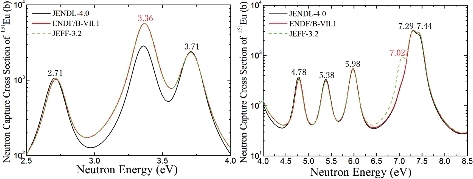
In the present study, we have measured the neutron capture cross sections of 151Eu and 153Eu by the time-of-flight (TOF) method at the KURRI-LINAC. The purposes of the present study are as follows:
| (1) | To determine the resonance parameters for 151Eu and 153Eu in the energy region from 1 to 20 eV. | ||||
| (2) | To examine the validity of the evaluated values in the JENDL-4.0, ENDF/B-VII.1, and JEFF-3.2 in the resolved resonance energy region. | ||||
For a detailed analysis of resonance peaks to obtain the corresponding resonance parameters, the BGO assembly having the high detection efficiency was used as the capture γ-ray measurement. We have carried out the resonance analysis of the present experimental data using the multi-level R-matrix Bayesian code SAMMY [Citation13,Citation14], and the obtained resonance parameters are compared with the JENDL-4.0 and the latest data of Leinweber et al. [Citation8]. Leinweber et al. [Citation8] performed transmission and neutron capture measurements to determine the resonance parameters of 151Eu and 153Eu by using LINAC at the Rensselaer Polytechnic Institute in the energy range 0.01 to 200 eV.
For the validity examination of the evaluated values, the measured capture cross sections of 151Eu and 153Eu are also compared with the evaluated values in JENDL-4.0, ENDF/B-VII.1, and JEFF-3.2.
2. Experiment by time-of-flight method
2.1. Experimental arrangement
The energy-dependent capture cross section measurements of 151 Eu and 153Eu have been carried out by the TOF method using the KURRI-LINAC. The experimental arrangement is shown in . A water-cooled tantalum (Ta) target was used as a pulsed neutron source [Citation15] and this target was set at the center of an octagonal water moderator of diameter 30 cm and length 10 cm to moderate the neutron energies [Citation16]. Two lead (Pb) shadow bars (5 × 5 cm2 in area and 10 cm in length) were put in front of the neutron flight tube to reduce the γ-flash generated by the electron burst from the Ta target. We used the neutron flight tube in the direction of 135° to the KURRI-LINAC and the neutron flight length from the Ta target to the sample was 12.70 ± 0.02 m. An assembly of 12 pieces of Bi4Ge3O12 (BGO) scintillators [Citation17,Citation18] was set at the sides of the sample as shown in . To shield the neutrons scattered by the sample, the BGO assembly was covered by 6LiF tiles (3 mm in thickness). To monitor a neutron intensity during measurement, a BF3 was set at the outer entrance of the neutron flight tube.
The KURRI-LINAC was operated with a repetition rate of 50 Hz, a pulse width of 100 ns, and an average current of 13 µA.
2.2. Sample
The characteristics and chemical impurities of the samples used in the present measurements are summarized in and . The 151Eu and 153Eu were obtained from ISOFLEX USA and had >99.8 weight percent europium. Each sample of 151Eu and 153Eu in a form of powder was packed in an aluminum foil. A 10B sample in the form of powder was packed in a thin aluminum case (0.1 mm in thickness) and used for the measurement of the incident neutron spectrum on the sample. A sample of natural carbon metal plate was used for the experimental investigation of background effect caused by scattering neutrons in the 151Eu, 153Eu samples.
Table 1. Characteristics of samples
Table 2. Chemical impurities in the 151Eu and 153Eu samples
2.3. Detector and measurements
For the detection of the prompt γ-rays emitted from the sample, the BGO assembly with high detection efficiency was employed in the present measurement. The BGO assembly used in the present measurement is shown in . We used the 12 BGO scintillators produced by Hitachi Chemical Industry Co., Ltd. and each size of the scintillator was 7.5 × 5.0 × 5.0 cm3. The sample was inserted at the center of the BGO through-hole and the BGO through-hole size was 1.8 × 1.8 cm2. Output signals from the BGO assembly were stored in the Yokogawa's WE7562 multi-channel analyzer as the two dimensional data of the pulse-height and TOF. A block diagram of electronics for the data acquisition system is shown in .
The measuring times are listed in . The experiments were cyclically made with the 151Eu, 153Eu samples, an Al foil (the same as enclosing the Eu sample), the 10B sample, the 10B case, and the 10B sample with the resonance filters. The background was estimated from in-beam measurement of the Al foil, 10B case or blank. The background level was also confirmed by the resonance filters of In (1.46 eV), Ag (5.19 eV), Co (132 eV), and Mn (336 and 2.37 keV) inserted into the neutron flight tube.
Table 3. List of measuring times
3. Data processing
The neutron capture cross sections σγ(En) for the 151Eu and 153Eu samples are given by the following equation (1)
(1) where Ys(En) is the capture yield of the sample, ns is the thickness of the sample (atoms⋅b−1), Cs(En) is the net capture counting rate of the sample (s−1), φn(En) is the incident neutron spectrum on the sample (s−1), ϵs(En) is the BGO detection efficiency for the sample. fs1(En) is the correction factor for the isotopic impurity, and fs2(En) is the correction factor for neutron self-shielding and multiple-scattering in the sample. Since the BGO scintillator is regarded as a total energy absorption detector, we assumed that the BGO detection efficiency for the sample is independent of the incident neutron energies.
The incident neutron spectrum can be given by (2)
(2) where B is the 10B sample, CB(En) is the net capture counting rate of the 10B sample (s−1), nB is the thickness of the 10B sample (atoms⋅b−1), σB(En) is the 10B(n,αγ)7Li reaction cross section (b), ϵB is the detection efficiency for the10B(n,αγ)7Li reaction. fB1(En) is the correction factor for the isotopic impurity in the 10B sample and fB2(En) is correction factor for the neutron self-shielding and multiple-scattering in the 10B sample. σB(En) was derived from the JENDL-4.0.
In the present measurement, the measurement data were normalized by the counting rate of the BF3 counter. The net capture counting rates Cs(En) of the 151Eu and 153Eu samples and CB(En) of the10B sample were obtained by subtracting the measurement results of the Al foil and the 10B case from the measurement results of the 151Eu,153Eu, and the 10B.
From EquationEquations (1)(1)
(1) and (Equation2
(2)
(2) ), the neutron capture cross section σγ(En) of the sample was obtained as follows:
(3)
(3)
The data analysis procedures are shown in . In the present study, the experiment was carried out by the relative measurements. Therefore, normalizations were needed to obtain absolute values of the capture cross section. Referring to our previous study [Citation9], the relative capture cross sections of 151Eu and 153Eu were normalized to the thermal capture cross section (9169 b) of JENDL-4.0 and that (358 b) of ENDF/B-VII.1.
4. Corrections
4.1. Correction for isotopic impurity
The neutron capture yield taking account of the isotopic impurity effect can be expressed by the following equation (4)
(4) where ℓ denotes the isotopic impurity and Yexp(En) is the experimental yield. Therefore, EquationEquation (4)
(4)
(4) should be expressed by the following equation
(5)
(5) where σ(En) is the neutron capture cross sections of the sample (b) and n is the thickness of the sample (atoms⋅b−1). In the present isotopic impurity correction, the neutron capture cross sections of 151Eu were derived by the JENDL-4.0, and the neutron capture cross sections of 153Eu were taken from the ENDF/B-VII.1.
The results of these correction factors fs1(En) are shown in . As for the 153Eu sample, the impurity 151Eu contributed largely to the energy region below 2 eV and the resolved resonance energy region. As for the 151Eu sample, the impurity 153Eu contributed largely to the resolved resonance energy region.
For the 10B sample, the isotopic impurity effect was considered to be negligible as the capture cross section and the amount of impurity of 11B are small.
4.2. Corrections for neutron self-shielding and multiple-scattering
In the present measurement, we have employed the MCNP-4C [Citation19] to calculate the correction factor fs2(En) of neutron self-shielding and multiple-scattering in the sample. In this calculation, the sample size, thickness, and impurity were considered to be the same as the experimental conditions. The sample was irradiated by the parallel neutron beams. The random histories in the calculation were 4 × 108. The correction factor fs2(En) was obtained as the ratio of capture yield of the sample to that of thin sample ideally without the effect of the self-shielding and multiple-scattering in the sample. Referring to our previous study [Citation9], the cross section data of 151Eu and 153Eu used for the calculation were taken from the JENDL-4.0 and ENDF/B-VII.1.
The correction factors fs2(En) for the 151Eu and 153Eu samples are shown in . As for the 151Eu sample, the correction factors became larger in the energy region below 0.1 eV and around the 0.46-eV resonance. For the correction factors of the 153Eu sample, the largest correction factor was about 1.39 around the 2.46-eV resonance.
Figure 7. Correction factors for the neutron self-shielding and multiple-scattering in the 151Eu and 153Eu samples.

For the 10B sample, the correction factor fB2(En) of the neutron self-shielding and multiple-scattering in the 10B sample were calculated by the MCNP-4C [Citation19] with JENDL-4.0.
5. Uncertainties
The following uncertainties were taken into account in the error estimation of the present measurement: the statistical error of the TOF spectrum and the systematic errors such as 10B(n,αγ) reaction cross sections, sample thickness, corrections, and the uncertainty of normalization at thermal energy. The main uncertainties were the statistical errors, especially in the resonance energy region. The experimental uncertainties in the present measurements are summarized in .
Table 4. Experimental uncertainties
The errors of the 10B(n,αγ) reaction cross sections were estimated to be about 0.2%–1.6% and those errors were derived from the estimated uncertainties of 10B(n,αγ) reaction cross sections in JENDL-4.0.
The error of sample thickness was caused by the uncertainty of sample weight and sample size. The sample thickness errors of the 151Eu and 153Eu were estimated to be about 2.4%. Measurement uncertainties assumed to be the sample weight about 1.1% and the sample size about 2.2%, respectively.
The correction errors of the isotopic impurity were estimated to be about 0.1%–5.8% and 0.1%–7.8% for the 151Eu and 153Eu samples using the uncertainty of isotope composition as listed in . In the present study, the effects of the chemical impurity and moisture in the 151Eu and 153Eu samples were considered as the systematic errors. The effect of the chemical impurity was estimated using the maximum values in with JENDL-4.0. The effect of moisture in the 151Eu and 153Eu samples was calculated using the MCNP-4C [Citation19] with JENDL-4.0 under the assumption of 5% H2O at maximum.
The correction errors of the neutron self-shielding and multiple-scattering in the sample were estimated to be about 2.1%–3.5% and 1.9%–3.5% for the 151Eu and 153Eu samples. Those errors were considered with the standard deviation of the numerical result with the MCNP-4C [Citation19] and the geometry error due to uncertainty in the sample thickness.
In the present measurement, the relative neutron capture cross sections were normalized to the evaluated value (9169 b) of 151Eu in JENDL-4.0 and (358 b) of 153Eu in ENDF/B-VII.1 at thermal neutron energy. However, since there was no information on the uncertainty of the evaluated thermal cross sections of 9169 b and 358 b for 151Eu and 153Eu, the errors of the normalization were not included in the present study.
6. Evaluation
6.1. Evaluation of neutron capture cross section
In the present study, the neutron capture cross sections of 151Eu and 153Eu were obtained in the energy range from 0.005 to 100 eV. In order to confirm the reliability of the evaluated values used for the correction factor of the neutron self-shielding and multiple-scattering in the sample, we compared the obtained neutron capture cross sections of 151Eu and 153Eu with the evaluated values in JENDL-4.0 and ENDF/B-VII.1.
and show the obtained neutron capture cross sections of 151Eu and 153Eu in the energy range from 1 to 10 eV. A residual is the difference between the obtained neutron capture cross section data and the evaluated values used for the correction factor of the neutron self-shielding and multiple-scattering in the sample. For the 151Eu, we found that there are large discrepancies between the obtained data and evaluated values in JENDL-4.0 at the 3.37-, 4.78-, 7.00-, 7.22-, and 7.42-eV resonances. For the 153Eu, the evaluated values in ENDF/B-VII.1 at the 2.46-, 3.29- and 3.94-eV resonances are larger than the obtained data.
From these results, we confirmed that there were problems of validity in the evaluated values for some resonances, and thus the resonance analysis of 151Eu and 153Eu was performed for further study.
6.2. Resonance analysis
The resonance analysis for the 151Eu and 153Eu was executed in the energy region from 1 to 20 eV. In this analysis, the resonance parameters of resonance energy E, neutron width Гn, and gamma width Гγ were determined by using the SAMMY code with Reich–Moore formalism. The nuclear radii used in the present analysis were taken from the JENDL-4.0, 8.3 fm for 151Eu, 8.6 fm for 153Eu. For other parameters (total angular momentum J and spin of the target nucleus I), those of the JENDL-4.0 were employed. Those parameters are listed in and . Then, the present experimental data for the 151Eu and 153Eu were used for fitting in the region below 20 eV. The experimental resolution, Doppler broadening, neutron self-shielding, and multiple-scattering in the sample were considered at the resonance analysis. To obtain the best fit, a 12.48-eV resonance in the 151Eu has been added to our experimental data, and this resonance information was referenced from the data of Leinweber et al. [Citation8]. The components of the neutron flight length, pulse width, and resolution function were considered at the fitting error of the resonance parameter. The obtained resonance parameters and fitting errors of 151Eu and 153Eu are listed in and . In the tables, the resonance parameters and their errors are given and compared to those of JENDL-4.0 and Leinweber et al. [Citation8].
Table 5. Obtained resonance parameters for the 151Eu compared with the JENDL-4.0 and the Leinweber's parameters
Table 6. Obtained resonance parameters for the 153Eu compared with the JENDL-4.0 and the Leinweber's parameters
6.3. Modification of neutron self-shielding and multiple-scattering
Since the present experimental data were different from the evaluated cross section values for some resonances, it is not suitable to use the evaluated nuclear data libraries for the correction of the neutron self-shielding and multiple-scattering in the sample. For this reason, we revised the cross section values using the obtained resonance parameters as listed in and . The revised values modified with the obtained resonance parameters were provided in the ACE format nuclear data library using the NJOY [Citation20] program.
A comparison of the correction factors fs2(En) for the 151Eu in the energy region 2.5 to 8.5 eV using the JENDL-4.0 and the revised values are shown in . The correction factors were revised upward approximately 12% in the 3.37-eV resonance. The correction factors for the 7.00-, 7.22-, and 7.42-eV resonances were also revised upward approximately 7%.
7. Results and discussion
We have acquired the neutron capture cross sections of 151Eu and 153Eu with a high energy resolution enough to distinguish the detailed resonance structure. The resonance analysis was performed for 20 resonances of 151Eu and 17 resonances of 153Eu in the energy region from 1 to 20 eV. In the correction of the neutron self-shielding and multiple-scattering in the sample, the evaluated values were modified with the obtained resonance parameters. Consequently, the correction factors were revised with the results of resonance analysis as shown in Section 6. In order to examine the validity for the evaluated nuclear data libraries, we compared the obtained resonance parameters with the evaluated values in the JENDL-4.0 and the results by Leinweber et al. [Citation8] as listed in and . We also compared the neutron capture cross sections obtained in the work with the evaluated values in JENDL-4.0, ENDF/B- VII.1, and JEFF-3.2 in the neutron energy region from 0.005 to 100 eV as shown in .
and show a part of the resonance energy region interested in this work. The residual is the difference between the present capture cross section results and the evaluated values (JENDL-4.0 or ENDF/B- VII.1) or between the present capture cross section results and the revised values.
7.1. Resonance parameters of 151Eu
It is worth noting that Leinweber et al. [Citation8] reported a new resonance at 12.5 eV. In this work, the resonance peak was observed around 12.5 eV, and the Leinweber's neutron width is in good agreement with the present fitting result within error. Generally, the present analysis results show the same tendency as the results by Leinweber et al. [Citation8].
It should be noted that there are large discrepancies of neutron widths between the evaluation in the JENDL-4.0 and the present analysis for the 3.37-, 4.78-, 7.00-, and 7.42-eV resonances.
7.2. Neutron capture cross sections of 151Eu
The peak area in the JENDL-4.0 is about twice as small as those in the ENDF/B- VII.1 and JEFF-3.2 for the 3.37-eV resonance. The present results are in good agreement with those in the ENDF/B- VII.1 and JEFF-3.2. For the 4.78-eV resonance, the peak area in every library is about twice as large as that in the present results. For the 7.00-, 7.22-, and 7.42-eV resonances, overall discrepancies were observed.
As shown in (b), the present results are consistent with the revised cross sections based on the resonance analysis rather than the evaluated values in JENDL-4.0. In particular, the residuals have been improved up to about 80% in the 3.37-eV resonance. In the 7.00-, 7.22-, and 7.42-eV resonances, the residuals have been improved up to about 90%.
7.3. Resonance parameters of 153Eu
As for the large resonances, the Leinweber's neutron widths were larger than the present analysis results. On the other hand, the Leinweber's neutron widths agree with the present analysis results for the 6.15-, 12.40-, and 15.27-eV resonances.
The obtained neutron widths are about 20% smaller than those in JENDL-4.0 for the 2.46-, 3.29-, and 3.94-eV resonances. Except for those resonances, the present analysis results are in general agreement with the evaluated values in JENDL-4.0.
7.4. Neutron capture cross sections of 153Eu
The peak areas in the JENDL-4.0, ENDF/B-VII.1, and JEFF-3.2 are about 15% larger than those in the present results for 2.46-, 3.29-, and 3.94-eV resonances.
As shown in (b), the present results are in general agreement with the revised cross sections based on the resonance analysis rather than the evaluated values in ENDF/B-VII.1. Especially, the residuals have been improved up to about 70%, 50%, and 90% in the 2.46-, 3.29-, and 3.94-eV resonances.
For the regions between resonance peaks of 151Eu and 153Eu, there are discrepancies of the neutron capture cross section between the present results and every evaluation values.
8. Conclusions
In the present work, the neutron capture cross section measurements of 151Eu and 153Eu were carried out with the BGO assembly using the TOF method at the KURRI-LINAC. The neutron capture cross sections of 151Eu and 153Eu were normalized to the evaluated thermal cross sections in JENDL-4.0 and ENDF/B-VII.1, respectively. We have obtained the resonance parameters for the 151Eu and 153Eu by the SAMMY code in the energy range from 1 to 20 eV. The obtained resonance parameters were used for the corrections of the neutron self-shielding and multiple-scattering in the sample. We were able to acquire the detailed resonance cross sections of 151Eu and 153Eu. The present study can be concluded as follows:
(1) 151Eu
In the present study, we determined the resonance parameters of the 20 resolved resonances in the energy region from 1 to 20 eV. We acquired the neutron capture cross sections in the energy region from 0.005 to 100 eV.
The present analysis results show overall agreement with the Leinweber's neutron widths in the neutron energy region from 1 to 20 eV.
The present measurement results indicate that the 3.37-eV resonance of JENDL-4.0 is underestimated. In the 4.78-eV resonance, the present measurement results show that the evaluated values in JENDL-4.0, ENDF/B-VII.1, and JEFF-3.2 are overestimated. For the 7.00-, 7.22-, and 7.42-eV resonances, present measurement results are different from every evaluation values.
(2) 153Eu
We determined the resonance parameters of the 17 resolved resonances in the energy region from 1 to 20 eV and acquired the neutron capture cross sections in the energy region from 0.005 to 100 eV.
The present analysis results and measurement results show that the evaluated values in JENDL-4.0, ENDF/B-VII.1, and JEFF-3.2 and the Leinweber's neutron widths are larger than the present results for 2.46-, 3.29-, and 3.94-eV resonances.
Acknowledgments
The authors are grateful to all the staff of the Kyoto University Research Reactor Institute-Linear Accelerator (KURRI-LINAC) for making it possible to operate the LINAC steadily.
Disclosure statement
No potential conflict of interest was reported by the authors.
References
- Nuclear Fuel Cycle Facility Safety Research Committee. [A guide introducing burn-up credit, preliminary version]. Tokyo: Japan Atomic Energy Research Institute; 2001. ( Report no. JAERI-Tech 2001-055). Japanese.
- Chiba G. Okumura K, Oizumi A, et al. Sensitivity analysis of fission product concentrations for light water reactor burned fuel. J Nucl Sci Technol. 2010;47:652–660.
- Rahn F, Camarda HS, Hacken G, et al. Neutron resonance spectroscopy. IX. The separated isotopes of samarium and europium. Phys Rev. 1977;6:251–265.
- Konks VA, Popov YP, Fenin YI. Radiative capture of neutrons by nuclei with A = 140–200. Sov J Nucl Phys. 1968;7:493–499.
- Widder F. Neutron capture cross section measurements in the energy region from 0.01 to 10 electron volts. Austria: Swiss report to the I.N.D.C; 1975. ( Report no. 009).
- Moxon MC, Endacott DAJ, Jolly JE. The neutron capture cross-section of 151Eu and 153Eu in the energy range 0.1 to 100 keV. J Nucl Ener. 1976;3:399–403.
- Basunia MS, Firestone RB, Révay Z, et al. Determination of the 151Eu(n,γ)152m1,gEu and 153Eu(n,γ)154Eu reaction cross sections at thermal neutron energy. Nucl Data Sheets. 2014;119:88–90.
- Leinweber G, Barry DP, Burke JA, et al. Europium resonance parameters from neutron capture and transmission measurements in the energy range 0.01-200 eV. Ann Nucl Energy. 2014;69:74–89.
- Lee J, Hori J, Nakajima K, et al. Neutron capture cross section measurements of 151,153Eu using a pair of C6D6 detectors. J Nucl Sci Technol. 2017;54(10):1046–1057.
- Chadwick MB, Herman M, Obložinský P, et al. ENDF/B-VII.1 Nuclear data for science and technology: cross sections, covariances, fission product yields and decay data. Nucl Data Sheets. 2011;112:2887–2996.
- Shibata K, Iwamoto O, Nakagawa T, et al. JENDL-4.0: a new library for nuclear science and engineering. J Nucl Sci Technol. 2011;48:1–30.
- The JEFF team. JEFF-3.2: evaluated nuclear data library. 2014 [cited 2017 Nov. 1]. Available from: http://www.oecd-nea.org/dbfroms/data/eva/evatapes/jeff_32.
- Larson NM. Innovations in the analysis code SAMMY. J Nucl Sci Technol. 2002;2:92–95.
- Larson NM. Updated users guide for SAMMY: multilevel R-matrix fits to neutron data using Bayes equations. Oak Ridge: Oak Ridge National Laboratory; 2008. ( Report no. ORNL/TM-9179/R8).
- Kobayashi K, Jin G, Yamamoto S, et al. KURRI-LINAC as a neutron source for irradiation. Osaka: Research Reactor Institute of Kyoto University; 1989. ( Report no. 22).
- Sano T, Hori J, Takahashi Y, et al. Analysis of energy resolution in the KURRI-LINAC pulsed neutron facility. In. Plompen A, Hambsch FJ, Schillebeeckx P, et al., editors. Proceedings of ND 2016 International Conference on Nuclear Data for Science and Technology; 2016 Sep 11–16, Bruges, Belgium. Les Ulis Cedex: EDP sciences; 2017. Vol. 146, p. 03031.
- Yamamoto S, Kobayashi K, Fujita Y. Application of BGO scintillators to absolute measurement of neutron capture cross sections between 0.01 and 10 eV. J Nucl Sci Technol. 1996;33:815–820.
- Lee S, Yamamoto S, Kobayashi K, et al. Neutron capture cross-section measurement of rhodium in the energy region from 0.003 eV to 80 keV by Linac time-of flight method. Nucl Sci Eng. 2003;144(1): 94–107.
- Briesmeister JF, editor. MCNP – a general Monte Carlo N-Particle transport code, Version 4C. New Mexico: Los Alamos National Laboratory; 2000. ( Report no. LA-13709-M).
- Muir DW, Boicourt RM, Kahler AC, editors. The NJOY nuclear data processing system, Version 2012. New Mexico: Los Alamos National Laboratory; 2012. ( Report no. LA-UR-12-27079).

